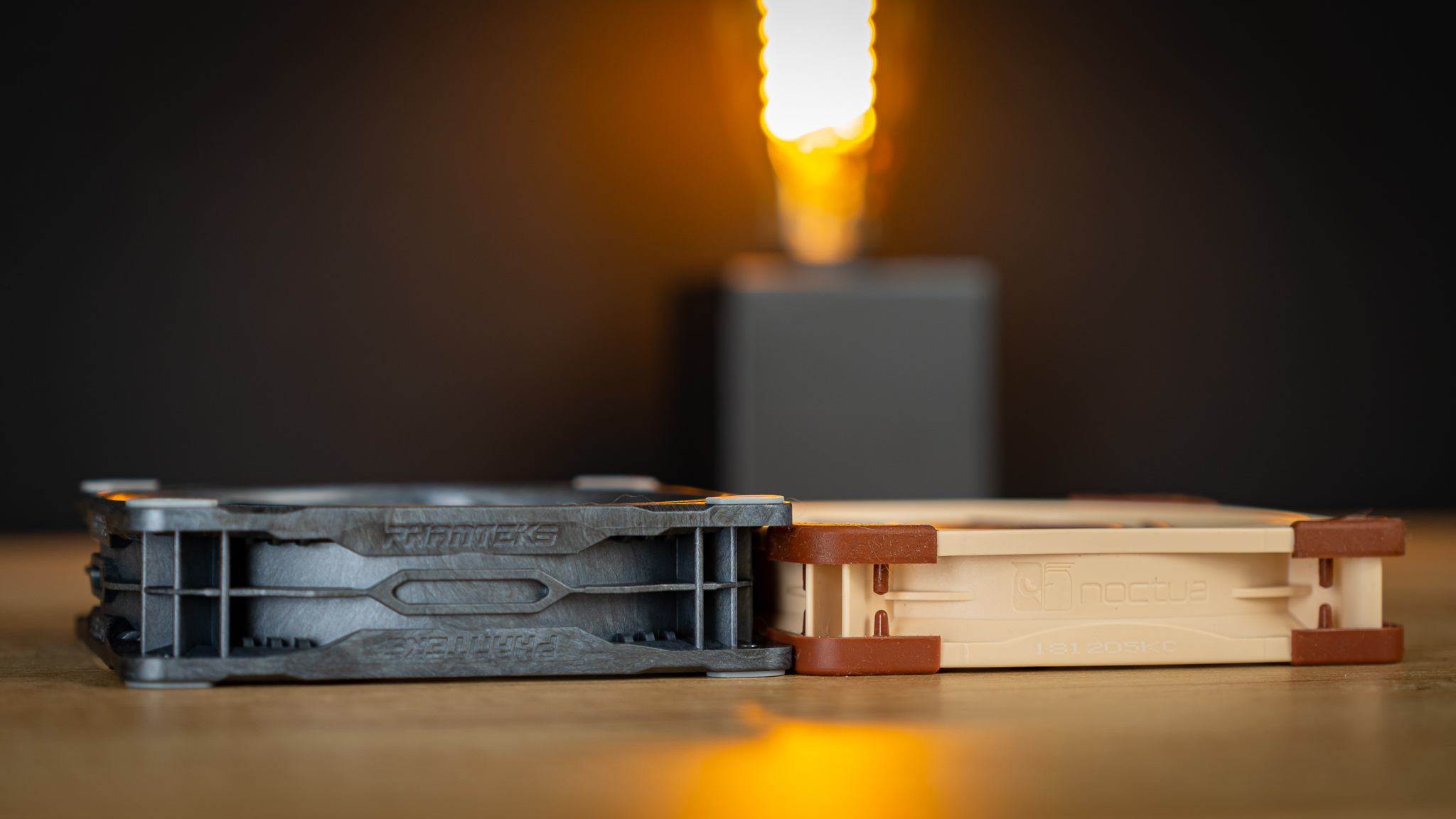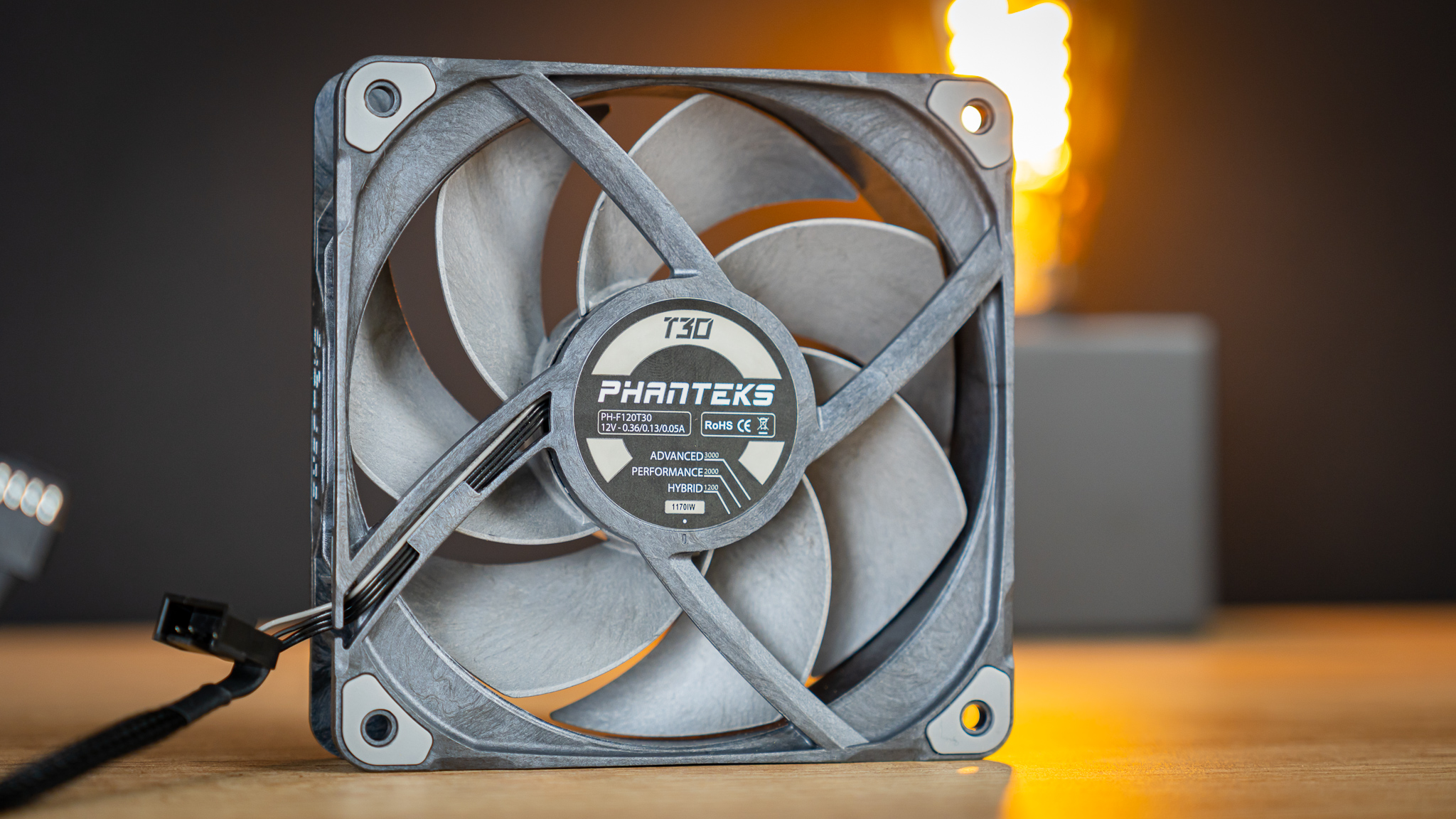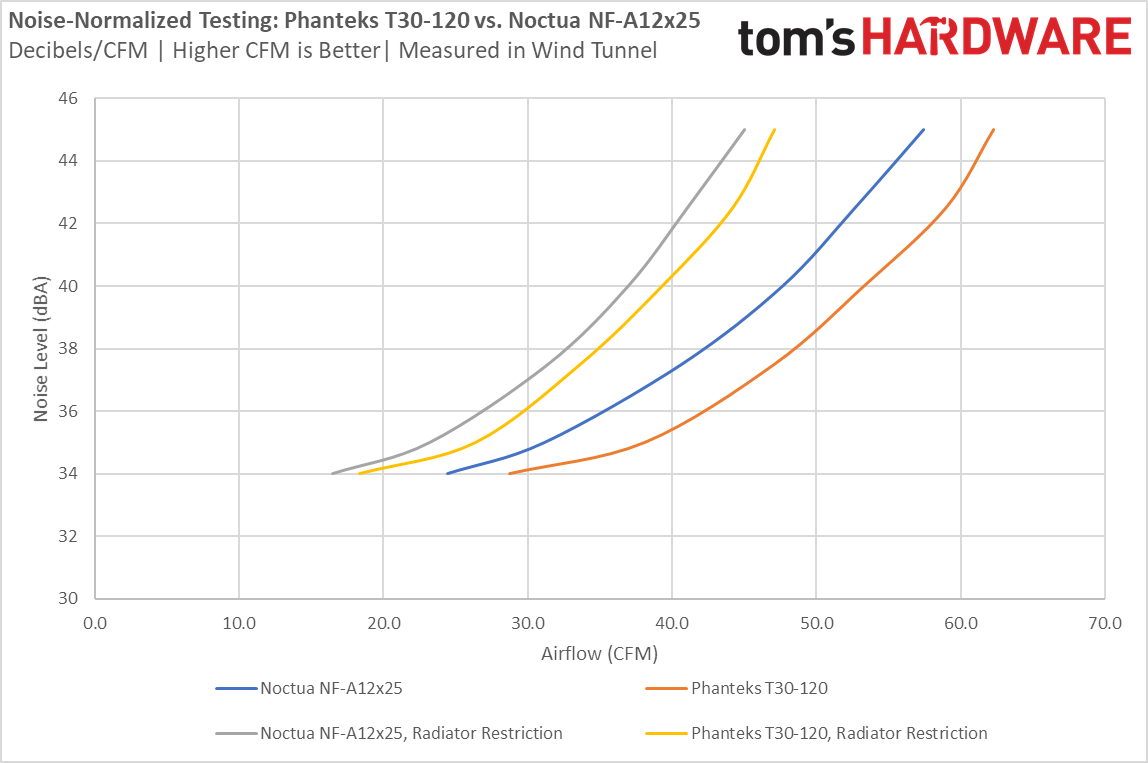Testing Phanteks’ T30-120: Dethroning Noctua’s Finest
But, is Phanteks cheating?
A few months ago, when I was visiting Phanteks to pick up a case for review, I spotted something in the corner of my eye: A fan that I hadn’t seen before. I asked about it, but was quickly told that I wasn’t supposed to see that and swiftly hushed out the door. Fast forward to today, and I have four Phanteks T30-120 fans on the test bench, along with a wind-tunnel to put it through its paces.
All Phanteks told me back then was that this fan would be better than Noctua’s best spinners, triumphing its performance by a healthy margin. Of course, I was skeptical, but it’s now here, and lo and behold, the T30-120 is actually impressively good. Because Phanteks claims that the T30-120 is the ultimate fan, I’m mercilessly pitting it against the Noctua NF-A12x25 – the benchmark for fan excellence in today’s market.
Let’s dig in.
What is the T30-120’s secret?
Much like Noctua’s flagship fan, the NF-A12x25, the T30-120 is built using forward-swept fan blades made from a liquid crystal polymer (LCP) material, edging extremely close to the frame at just 0.5mm for maximum static pressure. But whereas Noctua’s spinner is built with nine blades, Phanteks’ T30-120 only has seven. Unlike Noctua’s fan, the T30-120’s frame is also made from the LCP material and comes with rubber anti-vibration pads glued on at the corners, so there is no radiator gasket.
At the center, you’ll spot the fan’s motor, which is a SUNON-made 3-phase hub with a magnetic, levitated dual-vapo bearing. This is an extremely quiet and smooth motor, with a long rated lifetime. It’s also an extremely powerful motor, as the fan is capable of spinning at up to 3000 RPM.
But there is another reason why the hub has to be quite powerful, and this is the real secret of how the T30-120 outperforms Noctua: Phanteks is kind of...cheating. Okay, I kid. But the T30-120, unlike the vast majority of 120mm fans, doesn’t restrict itself to the 25mm standard for frame thickness. Rather, the T30 is, as its name implies, 30mm thick, giving room for 25% larger fan blades and thereby more performance. Of course, this trick nuances the performance uplift somewhat as it’s no longer a 120x120x25mm fan, but performance is still performance. And lots of fan applications have room for a thicker fan.
One SKU to rule them all
From the factory, the T30-120 comes configured to spin at ‘just’ 2000 RPM, responding to the PWM signal in a linear fashion. To get to 3000 RPM, you’ll have to flip a switch at the back of the fan to pop it into ‘Advanced’ mode. Do be careful with this mode though, as it’s so fast that you will hurt your fingers in the fan if you touch it during operation.
Get Tom's Hardware's best news and in-depth reviews, straight to your inbox.
For silence enthusiasts too lazy to set their own PWM curves, there’s another mode: Hybrid. This one limits the maximum rotational speed to just 1200 RPM, and at PWM signals below 50%, completely shuts the fan off.
Having all these different modes at the flip of a switch is actually a great way of keeping the product line simple and giving the customer easy flexibility – there are no separate SKUs for the different flavors, nor do you need to mess about with messy low-noise adapters. Just buy the fan and use it as you intend, and if you ever feel you want a different fan mode, just flip the switch at the back to take the fan from whisper quiet to brutally powerful.
Other than that, there really isn’t much to the T30-120. It does come with a daisy-chained cable to spare you the pain of splitters, and because it’s a little thicker than most, it comes with longer screws so that you can still fix it to your AIO or radiator of choice. Heck, it even comes with a second set of even longer screws than the already-extended ones, because Phanteks also sells the digital Halos (which we used in the liquid-cooled Mirror Maze PC build), for when you want to turn this ultimate fan into the ultimate RGB fan.
Synthetic Testing: Phanteks T30-120 vs Noctua’s Finest
For the first test, I simply placed the fan in an open space, chucked the dB meter in front of it at 30cm, and measured the noise levels emitted throughout the RPM range with intervals of 250 RPM. Both the Phanteks and Noctua fans will happily turn at just 250 RPM at the lowest PWM signal, but whereas Noctua’s spinner wraps things up at about 2070 RPM, Phanteks’ T30-120 will soar well to 3000 RPM. In fact, it’s so powerful at this speed that the fan started pushing itself along my test bench. Hah.
The T30-120 came out louder than the Noctua NF-A12x25 at identical RPMs, but that’s no real surprise. With its thicker design, it should push more air at lower RPMs, and therefore achieve better acoustic efficiency. Hence the need for the next test.
Noise-Normalized Testing with a Wind Tunnel
For the next test, I decided to focus on noise-normalized performance using a wind tunnel. When I spotted the fan way back, I hinted to Phanteks that I was looking into proper fan testing, so they set up a full kit that I could use to test not only the T30-120, but also a ton of other fans in the future (stay tuned for more). This wind tunnel is extendable, can fit 120mm and 140mm fans, has air straighteners throughout it to (mostly) resolve any turbulence, and measures the air speed exiting the tunnel with an anemometer. Pretty simple.
For this series of noise-normalized tests, I wanted to know the fan’s performance at a handful of noise levels, both in open-air configurations and when restricted by a radiator. The lowest noise level I tested at was 34 dBA, as that is the noise floor in my office, at night. That’s a bit high for proper scientific tests, but still very quiet and most rooms will have a similar noise floor anyway. And let’s be fair, none of us live in an anechoic chamber – so the first value was the RPM figure the fans achieved right before breaking through the noise floor. After that, I measured from 35 dBA and upwards, noting down the rotational speed of each fan at 2.5 dBA increments.
Then, I chucked the fans onto the wind tunnel, set them at the rotational speeds I had recorded for each noise level (noise testing cannot be done on the tunnel as it echoes and resonates), and recorded the resulting air speeds for both fans, with and without a simple radiator as restriction, then using that value to calculate the airflow. This methodology isn’t real-world, think of it more as a ‘synthetic benchmark’ if you will, but it’s consistent, and the results don’t vary when the temperature in my room changes.
The results speak for themselves. Phanteks’ T30-120 merrily beats the Noctua NF-A12x25 with the highest airflow for each noise level. When restricted by a radiator, the difference isn’t quite as drastic as in open air, but the T30-120 still wins by a healthy margin.
A Word on Future Fan Testing
Of course, these are only synthetic tests – I’m sure you’re wondering where my real-world tests are. At this time, I’m still working on building a full fan testing setup that combines both synthetic and real-world testing on a PC. I would have liked to include a real-world result in this hands-on piece, but the setup isn’t complete yet. Sorry, you’ll have to wait until next time, but we’ll also be including more fans in the future.
Conclusion
Phanteks’ T30-120 might be ‘cheating’ a little by extending the frame to 30 mm thickness as opposed to the industry standard of 25 mm, but the company didn’t skimp on the rest of the spinner’s engineering. Sure, it’s not a Noctua level of refinement that’s going on here, but the results to speak for themselves: the 5-mm thicker T30-120 beats Noctua’s famous NF-A12x25 – a fan that is considered to be the best PC fan in the world – at least from a noise and acoustics point of view.
With this in mind, I’m not really upset that Phanteks decided to make the fan a little thicker. In fact, I’m actually surprised it took this long for anybody to do it at all – it’s such an obvious opportunity, and I’m curious whether this is the start of a new era of thicker PC fans. I’m curious how a 30-mm thick 120mm Noctua fan would perform, but I don’t expect to find that out anytime soon.
The T30-120 might not be the best-looking fan with its rough, industrial design (though it’s Noctua’s fans are visual stunners, either), and you’ll have to double-check whether it fits in the configuration you want to use due to the added thickness. But the thickness shouldn’t be an issue in the vast majority of builds, and if you want it with RGB, you can chuck on a Phanteks Halo light ring.
All things considered, between the exceptional performance, construction quality, speed switch, 6-year warranty, and daisy-chaining cables, the Phanteks T30-120 is an easy recommendation, even at its $29.99 price tag (which is also roughly the going rate for the competing NF-A12x25). I’m sorry Noctua, but first place is no longer yours – unless for some reason you need to stick to 25mm.
Niels Broekhuijsen is a Contributing Writer for Tom's Hardware US. He reviews cases, water cooling and pc builds.
-
Phaaze88 :whistle:, I may have to change my avatar...Give me a 140mm version, then I'll bite. I'm done with 120mm fans.Reply -
2Be_or_Not2Be You can't claim it beats the 25mm Noctua when it's 30mm. C'mon - test apples to apples, or don't claim it "beats" the Noctua as if it were an evenly-matched competition. Give it props on its own merits! If Noctua comes out with their own 30mm fan, then give it a proper head-to-head face-off.Reply -
vmem so in reality, they created a new 120mm form factor. the added 5mm is non-trivial, especially since a lot of people use rad fans in push-pull, which would add 10mm total. Though I agree that there are many applications where the extra height doesn't matter... Now I'm just waiting for someone to make a monster 50mm version :devilish:Reply -
hotaru251 yeah as above posts have stated not really "fair" to compare a 25 vs a 30.Reply
thats basically saying a normal rad beats a slim rad...well ya as they are using more material/space.
an 5mm is a hearty chunk of 25mm. 20% difference. -
honuswscruggs Replyhotaru251 said:yeah as above posts have stated not really "fair" to compare a 25 vs a 30.
Of course it's 'fair.' Provided one's use-case isn't sensitive to the difference in thickness, then saying that difference makes them incomparable is like saying you can't compare them cause they're not the same color.
No one has claimed that "this fan beats that fan, therefore Phanteks's engineers did a better job than Noctua's"—If they were, then the difference in thickness would be a key point of argument—They only claim made is more modest but also more relevant for most users: if you want to move air around and 30mm fits just as well as 25mm, then Phanteks's fan beats Noctua's. The tests demonstrate that to be the case. -
BillyBuerger If thinkness doesn't matter, you could always go for a 120x38mm fan. I was actually looking at some of those recently since my case was made to work with three of those (Sun Ultra 45). Thinking back to the old Panaflo's and such. But the only ones available I could find are super high speed monsters that likely would sound harsh at the 500rpm I would be running them. So I used my Scythe Slipstreams which work just fine as well. Thought about some Noctua's but those add up fast and would likely give similar results to what I have on hand.Reply -
closs.sebastien Such one is beating noctua too: https://www.legitreviews.com/images/reviews/843/aeroracer_012.jpgReply -
Unolocogringo I still have a couple panaflo 35x120mm fans that would probably put both of these to shame.Reply
Full metal frame and blades. Believe it was 180cfm@3000 rpm @12v. I have them wired for 7v on a molex connector. Almost silent but still moves a lot of air. -
cryoburner It's perfectly fair to compare this fan against others using a more standard thickness, since for the vast majority of use-cases, that shouldn't be an issue. Most case fans have plenty of space around them to accommodate a little extra thickness. It's just something to keep in mind for compatibility, and in some less common scenarios, one might need to go with a different fan instead. This is no different from comparing two different CPU coolers that are not the exact same dimensions, and in the case of CPU coolers, the differences will often be a lot more than just 5mm of additional thickness.Reply
The only thing is, they should probably be a little clearer about the fan being a bit thicker than usual. In the product description of the part on Amazon, shipped and sold by Phanteks USA, there appears to be no mention about the fan being 30mm thick. That's something they should note, seeing as it does break with the standard a little. -
OMGPWNTIME It's not really a secret that a fan with more depth will greatly increase CFM + Static Pressure; there's a reason that most server racks will commonly utilize 38mm depth fans. Although the reason is that server components generally employ 'passive' heatsinks only and use the very high SP/CFM rows and rows of fans to pull the air through the whole rack.Reply







